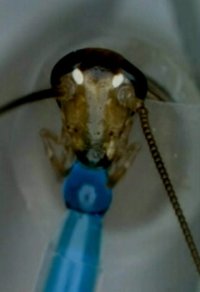Researchers in the USA have shown that German cockroaches have developed an aversion to the sugars which form a part of popular cockroach bait formulations.
These results are obviously significant should a bait be based on a sugar formulation. Something cockroach bait manufacturers need to be aware of. Or maybe they already are?
The news item from North Carolina State University details their results as shown below:
| In a study published on 24 May in the journal Science, North Carolina State University entomologists show the neural mechanism behind the aversion to glucose, the simple sugar that is a popular ingredient in roach-bait poison. Glucose sets off bitter receptors in roach taste buds, causing roaches to avoid foods that bring on this taste-bud reaction. This aversion has a genetic basis and it eventually spreads to offspring, resulting in increasingly large groups of cockroaches that reject glucose and any baits made with it.
In normal German cockroaches, glucose elicits activity in sugar gustatory receptor neurons, which react when exposed to sugars like glucose and fructose – components of corn syrup, a common roach-bait ingredient. Generally, roaches have a sweet tooth for these sugars. “We don’t know if glucose actually tastes bitter to glucose-averse roaches, but we do know that glucose triggers the bitter receptor neurons that would be triggered by caffeine or other bitter compounds,” says Dr Coby Schal, the Blanton J Whitmire Distinguished Professor of Entomology at NC State and the corresponding author of the paper. “That causes the glucose-averse roach to close its mouth and run away from glucose in tests.”
|
|
|
| In the study, the researchers conducted tests on the roach tongue, the paired mouth appendages called paraglossae. The tests showed the unexpected electrophysiological reactions that glucose stimulates both sugar and bitter receptor neurons, confirming behavioural tests that showed roaches quickly fleeing from glucose when presented with it.
Glucose-averse roaches that were forced to taste glucose refused to ingest the sugar, akin to a child who spits out her bitter-tasting food. Normal cockroaches, meanwhile, were happy to eat glucose. Researchers learned this by combining the glucose with food colouring and watching it get ingested or rejected by the normal or glucose-averse roaches, respectively. Schal says that the pest-control arms race has mostly been about pests gaining resistance to the insecticides themselves. This paper, however, shows an arms race that includes behavioural resistance to certain types of food – in this case, glucose. |
||


